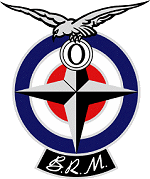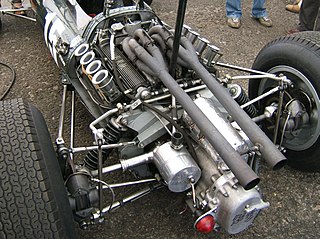
John Michael Hawthorn was a British racing driver. He became the United Kingdom's first Formula One World Champion driver in 1958, whereupon he announced his retirement, having been profoundly affected by the death of his teammate and friend Peter Collins two months earlier in the 1958 German Grand Prix. He died in a road accident three months after retiring.

John Norman Surtees, was a British Grand Prix motorcycle road racer and Formula One driver. On his way to become a seven-time Grand Prix motorcycle World Champion, he won his first title in 1956, and followed with three consecutive doubles between 1958 and 1960, winning six World Championships in both the 500 and 350cc classes. Surtees then made the move to the pinnacle of Motorsport, the Formula 1 World Championship, and in 1964 made motor racing history by becoming the F1 World Champion. To this day Surtees remains the only person to have won World Championships on both two and four wheels. He founded the Surtees Racing Organisation team that competed as a constructor in Formula One, Formula 2 and Formula 5000 from 1970 to 1978. He was also the ambassador of the Racing Steps Foundation.

British Racing Motors (BRM) was a British Formula One motor racing team. Founded in 1945 and based in the market town of Bourne in Lincolnshire, it participated from 1951 to 1977, competing in 197 grands prix and winning seventeen. BRM won the constructors' title in 1962 when its driver Graham Hill became world champion. In 1963, 1964, 1965 and 1971, BRM came second in the constructors' competition.

The 1950 British Grand Prix, formally known as The Royal Automobile Club Grand Prix d'Europe Incorporating The British Grand Prix, was a Formula One motor race held on 13 May 1950 at the Silverstone Circuit in Silverstone, England. It was the first World Championship Formula One race, as well as the fifth British Grand Prix, and the third to be held at Silverstone after motor racing resumed after World War II. It was the first race of seven in the 1950 World Championship of Drivers.

The 1951 British Grand Prix was a Formula One motor race held on 14 July 1951 at the Silverstone Circuit in Northamptonshire, England. It was race 5 of 8 in the 1951 World Championship of Drivers and was contested over 90 laps. The race was the first victory for José Froilán González, and was also the first of many for the Scuderia Ferrari team. Both the team and driver also achieved their first ever pole position during the weekend.

The 1961 Formula One season was the 15th season of Formula One motor racing. It featured the 1961 World Championship of Drivers and the 1961 International Cup for F1 Manufacturers, which were contested concurrently from 14 May to 8 October over an eight race series. The season also included numerous non-championship races for Formula One cars.
The 1957 Formula One season was the 11th season of FIA Formula One motor racing. It featured the 1957 World Championship of Drivers, which commenced on 13 January 1957 and ended on 8 September after eight races. Juan Manuel Fangio won his fourth consecutive title, his fifth in total, in his final championship. A feat that would not be beaten until Michael Schumacher in 2003. The season also included numerous non-championship races for Formula One cars.
The 1952 Formula One season was the sixth season of FIA Formula One motor racing. In comparison to previous seasons, the 1952 season consisted of a relatively small number of Formula One races, following the decision to run all the Grand Prix events counting towards the World Championship of Drivers to Formula Two regulations rather than Formula One. The Indianapolis 500, which also counted towards the World Championship, was still run to AAA regulations as in previous seasons. Since this season racing helmets were made mandatory in Formula One.
The 1951 Formula One season was the fifth season of FIA Formula One motor racing. It featured the 1951 World Championship of Drivers, which commenced on 27 May 1951 and ended on 28 October after eight races. The season also included 14 races open to Formula One cars but did not count towards the championship standings.
The 1950 Formula One season was the fourth season of the FIA's Formula One motor racing. It featured the inaugural FIA World Championship of Drivers, as well as several non-championship races. The championship, which commenced on 13 May and ended on 3 September, consisted of six Grand Prix races, each held in Europe and open to Formula One cars, plus the Indianapolis 500, which was run to AAA National Championship regulations. Giuseppe Farina won the championship from Juan Manuel Fangio and Luigi Fagioli.

Henry O'Reilly "Harry" Schell was an American Grand Prix motor racing driver. He was the first American driver to start a Formula One Grand Prix.

Peter John Collins was a British racing driver. He was killed in the 1958 German Grand Prix, just weeks after winning the RAC British Grand Prix. He started his career as a 17-year-old in 1949, impressing in Formula 3 races, finishing third in the 1951 Autosport National Formula 3 Championship.

Reginald Parnell was a racing driver and team manager from Derby, England. He participated in seven Formula One World Championship Grands Prix, achieving one podium, and scoring a total of nine championship points.

Richard James David "Dickie" Attwood is a British motor racing driver, from England. During his career he raced for the BRM, Lotus and Cooper Formula One teams. He competed in 17 World Championship Grands Prix, achieved one podium and scored a total of 11 championship points. He was also a successful sports car racing driver and won the 1970 24 Hours of Le Mans race, driving a Porsche 917, the first of Porsche's record 19 victories at the famous race.

William Ronald Flockhart was a British racing driver. He participated in 14 World Championship Formula One Grands Prix, achieving one podium finish and won the 24 Hours of Le Mans sportscar race twice.
The British Racing Motors V16 was a supercharged 1.5-litre V-16 cylinder racing engine built by British Racing Motors (BRM) for competing in Formula One motor racing in the immediate aftermath of World War II. Designed in 1947 and raced until 1954–55, it produced 600 bhp (450 kW) at 12,000 rpm, although test figures from Rolls-Royce suggested that the engine would be able to be run at up to 14,000rpm.

Peter Douglas Conyers Walker was an English racing driver. He was born in Huby, Yorkshire and died in Newtown, Worcestershire. He proved a strong driver in most disciplines, but was most adept in sports cars, winning the 1951 24 Hours of Le Mans race, and the Goodwood Nine-Hours in 1955. He effectively retired after a crash in 1956 left him with serious injuries.

The 2nd BRDC International Trophy meeting – formally the International Daily Express Trophy – was held on 26 August 1950 at the Silverstone Circuit, England. The race was run to Formula One regulations, and was held over two heats of 15 laps each, followed by a final race of 35 laps. Italian driver Nino Farina emerged the winner, in an Alfa Romeo 158, repeating his victory from the 1950 British Grand Prix, held at the same circuit in May. He beat his Argentine team-mate Juan Manuel Fangio, and British driver Peter Whitehead in a Ferrari. Other notable entrants were the two BRM V16 cars entered for Raymond Sommer, Peter Walker, Raymond Mays and Reg Parnell. However, their legendary lack of reliability resulted in neither car completing a lap in anger.

The BRM P261, also known as the BRM P61 Mark II, is a Formula One motor racing car, designed and built by the British Racing Motors team in Bourne, Lincolnshire, England. The BRM P261 was introduced for the 1964 Formula One season, and its design was an evolution of Tony Rudd's one-off BRM P61 car of 1963. The P261 had a relatively long racing career; variants of the car were still being entered for Formula One World Championship Grands Prix as late as 1968. During the course of their front-line career, BRM P261s won six World Championship races, in the hands of works drivers Graham Hill and Jackie Stewart, and finished second in both the Drivers' and Constructors' Championship standings in 1964 and 1965. Stewart, Hill and Richard Attwood also used works P261s to compete in the Tasman Series in 1966. The BRMs dominated, with Stewart winning four, Hill two, and Attwood one of the 1966 Tasman Series' eight races. Stewart also won the title. The works-backed Reg Parnell Racing team returned in 1967 with Stewart and Attwood, where Stewart added another two wins to his tally. In terms of races won and total championship points scored, the P261 was the most successful car in BRM's history.

The British Racing Motors V8 was a four-stroke, naturally aspirated, 1.5 L (92 cu in), V-8 racing engine, designed, developed and built by British Racing Motors (BRM) to compete in Formula One racing (although an enlarged 2.0 L version was used for sports car racing. It was built between 1962 and 1967, and came in two version; the P56, and the P60.















